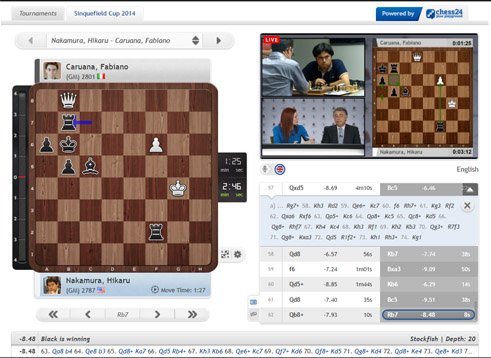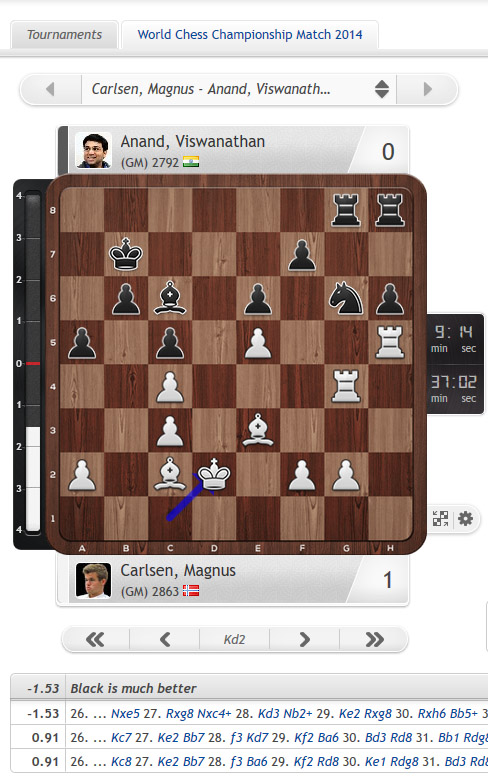New in Chess (2014/7)
.jpg)
Fabiano Caruana graces the cover of the current New in Chess after his memorable win at the Sinquefield Cup. His seven consecutive wins created a worldwide buzz about where his performance fit amongst the all-time greats. His performance rating was a computeresque 3097. However, this look at Caruana (who is maturing before our eyes), may give us a prequel of what is to come in the world of chess.
There was a handsome story done on the Sinquefield Cup, the second such tournament pitting four of the world’s top players. The powerful lineup of Magnus Carlsen, Caruana, Hikaru Nakamura and Maxime Vachier-Lagrave turned out to be the strong tournament in history (by average rating). Caruana shined in this historic result with a combination of superior preparation, cool nerves and consistent play.
Video by chess.com.
Caruana’s victory cast him in the world spotlight as he started the tournament at a 2801 and ended gaining 35 ELO points. There was an interesting interview done of Caruana which spoke on a wide range of topics including his beginnings, his emergence, his score against Carlsen and his incredible performance. (Note: While some jokingly attributed his play to his “ice water challenge” he was less than sure that it had contributed to his success.) While these subjects made for an interesting interview, every one is interested in whether he will change his federation to bolster and already powerful American side.
In the midst of how computers have transformed the game, many players (professional and amateur) rely on these “silicon beasts” to check their analysis. This feature becomes useful when following top flight chess. However, Dominic Lawson gives a caveat to fans summarily dismissing blunders with a click of a mouse and an evaluation by the chess engine.

Real-time analysis is a common theme in live coverage. It makes the game accessible to fans, but Lawson excoriates the practice of deferring to engine in almost a slave-like fashion.
Now every patzer can for less than the price of an average restaurant meal have at his disposal a program that could play 32 Kasparovs simultaneously and come out on top. Or, without even parting with a cent, he can log on to a site such as Chess Bomb and watch the top grandmasters’ games with simultaneously analysis from Stockfish working through 36,223,289 nodes at 22-ply.
Compelling idea.
Yet in his article he refers to Caruana’s game against Vachier-Lagrave at the Sinquefield Cup. In this game Caruana unfurled a serious bomb with 15.g4! In his annotations, Caruana said that Stockfish did not see this move, but preferred 15.Na4. A kibitizer at chessgames.com (named Chesswar1000) instantly gave the move 15.g4????? Thus it appears that humans are willingly deferring to chess engines to do their thinking. In the fact, 15.g4 would be assessed an !! How about Carlsen’s 26.Kd2?? in game six of the World Championship. Everyone howled when the computer spit out 26…Nxe5!

Lawson’s cynicism that a commentator like GM Maurice Ashley was being critical instead of merely inquiring about how a moved was missed seemed a bit over the top. It is certainly true that computers play a big role in watching live chess games, but one cannot conclude that finding instant blunders is not constructive. GMs do make mistakes and it is helpful to see the mistakes instantly. It is the same as spectators watching a football game on television and giving their opinion based on replays and commentary. No different. However, his point that fans automatically defer to chess engines to dismiss the intricate decision-making process of a human GM is well-taken.
A picture is worth a thousand words! Game 7 #CarlsenAnand #c24live pic.twitter.com/jFpwLEQXWT
— Claudia Munoz (@chesscampeona) November 17, 2014
The European Club Cup was covered in an 18-page spread! What is interesting is to see top-level GMs competing on the same side as erstwhile adversaries. An Azerbaijan team SOCAR was led by Veselin Topalov (Bulgaria) and Anish Giri (Netherlands), Wang Hao (China), Mickey Adams (England), Anton Korobov (Russia) and joined by Azeri players Shakhriyar Mamedyarov and Teimour Radjabov. In what is clearly the strongest collection of players outside of the Olympiad, this event brings with it an intrigue that makes it a model for other efforts. China has followed with a league of its own and of course you have the U.S. Chess League as well. Of course the others pale in comparison.

Viswanathan Anand won Bilbao this year with a sparkling performance and headed into his “rematch” with Magnus Carlsen in good form. Despite losing the mini-match to Levon Aronian, he had better tiebreaks. There was a prelude to the Carlsen-Anand world championship match by Sergey Shipov who gave a slightly more optimistic chance for the Indian. The article is an interesting read despite the fact that the match went in Carlsen’s favor 6.5-4.5. Anand did follow the 1.d4 path and got playable positions, but his missed 26…Nxe5! chance (mentioned above) was a matter of psychology if nothing else. Some opined that Anand did not expect Carlsen to blunder. Anand confirmed this by stating, “When you’re not expecting a gift, sometimes you don’t take it.”
.jpg)
Looking forward to the next issue of New in Chess!
Photo by Anastasia Kharlovich.
Le Quang Liem, a student at Webster University, is featured in “Just Checking”. The Vietnamese ace has a number of pleasures including hot chocolate, books like Harry Potter and movies like “Transformers”. However, when asked the immortal question, “What will be the nationality of the 2050 world chess champion,” he responds, “I hope Vietnamese :-).”
CONTENTS
- NIC’s Café
- Your Move
- Fair & Square
- Interview: Fabiano Caruana
- Beware: Brilliancy!
- Dialogues of the deluded
- SOCAR, so good
- Braveheart
- A kick from Pegasus
- Anand tests his form
- Repeat performance?
- S.O.S. in the QG Exchange
- Hou Yifan claims Grand Prix
- Topalov remains tops
- From Lasker to Larsen
- Just Checking
Link: https://www.newinchess.com/Shop/ProductDetails.aspx?ProductID=800
